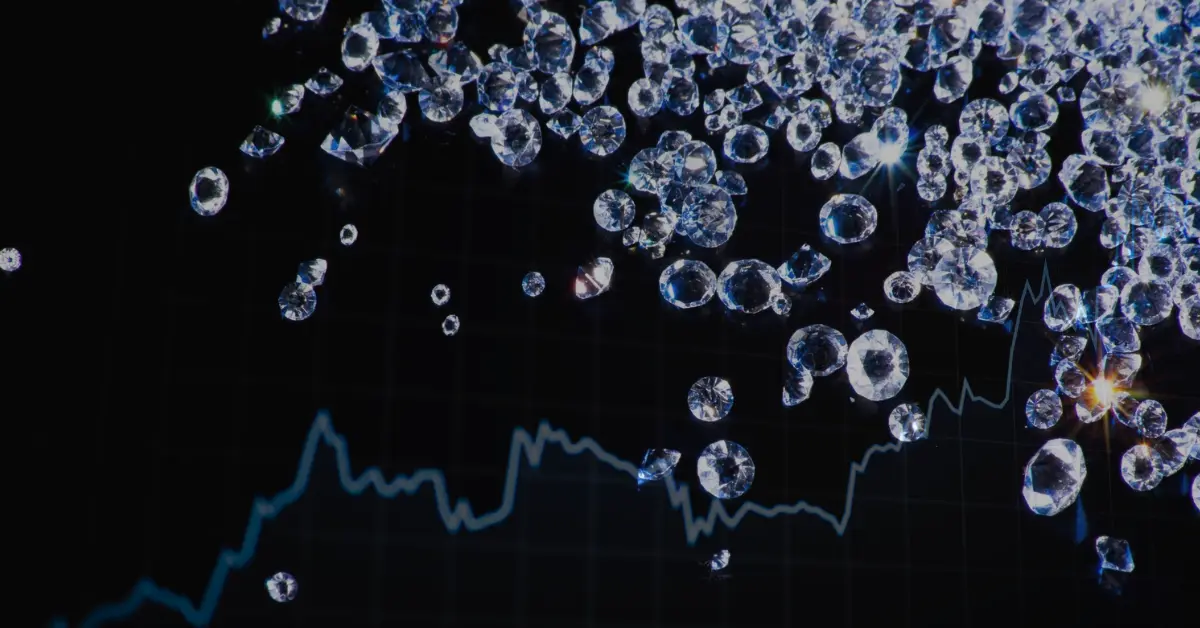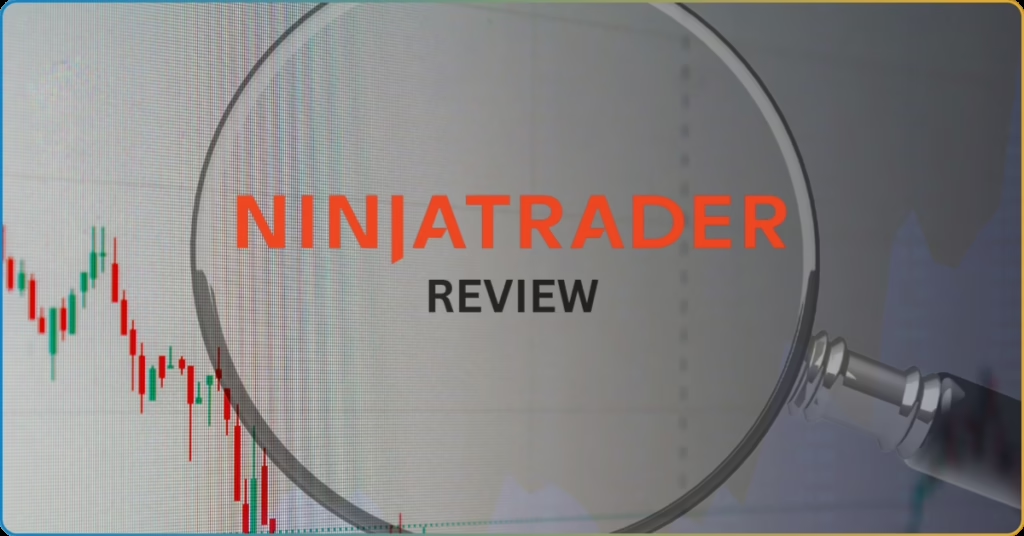Have you ever drawn a diamond shape in your price chart while charting?
That’s a diamond pattern, a chart pattern that indicates a potential reversal from a clear market trend. The diamond formation signifies the battle between buyers and sellers, which results in market indecision or price consolidation within a defined range.
Spotting this correctly could help you execute your trade to a profitable market point. Moreover, it could also safeguard your trade position in case the market reverses against it.
Like any chart pattern, having enough knowledge to maximize this market formation is an essential trading strategy and risk mitigation technique.
Read on to learn more about the diamond pattern and all the basic stuff you must know to spot, monitor, and ultimately profit from this market pattern.
What Is Diamond Pattern in Trading?
Diamond patterns indicate potential trend reversals from clear market trends. Essentially, they form a series of market tops and bottoms, which technical traders view as price consolidation.
There are two types of diamond patterns that form in the price chart, which are:
- Diamond top formation
- Diamond bottom formation
The only distinction between the two is whether they form during an uptrend or downtrend market, which determines the trend direction in which the market will reverse.
When the price trades near the bottom trend line, a diamond pattern suggests that it’s to reverse upward. Meanwhile, if it rallies up near the upper trendline, it tends to reverse downward anytime soon.
This makes spotting and trading the diamond pattern a common strategy to execute trades at attractive, profitable, and perhaps safe price points.
The name behind this pattern is a no-brainer. It’s called a diamond pattern because it resembles a diamond shape when it fully forms.
Note: The larger the pattern is, the more significant the signal is.
How Does Diamond Pattern Operate
The diamond formation entails that the asset price trades at a lower low before having a bullish reversal. Then, from its bullish reversal is a price that hits a higher high, followed by a bearish reversal.
This interchanging reversal trend continues until a diamond-shaped price chart is formed. Ultimately, it should have top and bottom trendlines that squeeze as they reach the middle, widening at the middle peak and yet again squeezing into a narrower range.
A breakout should conclude this pattern, which is the exact opposite of the trend in which it occurs.
You can further your diamond pattern analysis by using a drawing tool to connect the swing lows to swing highs. After everything is connected, the trend lines must form a diamond shape.
Does it have to be symmetrical?
The diamond doesn’t have to be perfect to tell you the potential market direction. The only symmetrical consideration here is whether the inversion points of diamonds form a symmetrical arc when converging to the middle.
But really, what does pattern formation tell you? During this market period, neither the buyer nor seller controls the market, thus, the price consolidation or market indecision.
Types of Diamond Chart Patterns
We have already established its credibility and reliability for effective and profitable charting. But really, what makes this pattern reliable to the point that traders recognize diamond pattern trading as an effective trading strategy?
Well, it lies in its complex formation. This pattern requires overly specific lower lows and higher highs, which means the moment it forms in your trading chart, it will most likely become self-fulfilling.
Diamond top pattern
All diamond chart patterns around the top of an uptrend market are called diamond top patterns.
This is also called the bearish diamond pattern. This chart pattern suggests that the ongoing upward trend will reverse to bullish after a sequence of market indecisions.
Diamond bottom pattern
On the other hand, if the market forms a diamond chart pattern at the bottom of a downtrend, it establishes a diamond bottom pattern.
This pattern formation is also called a bullish diamond pattern, which means the market will have a bullish reversal after a series of market indecisions.
Make sure to check out all three factors before you enter a trading position. Remember, the financial market is dynamic; it tends to roll out irrelevant diamonds. Trading these pseudo-diamonds is detrimental to your trading account because they don’t fulfill the trend they signal.
Main Features of Diamond Chart Patterns
With its intricate formation, the diamond chart patterns are considered rare in the financial market.
But here’s the question: what makes the diamond pattern a market pattern?
The price should be consolidated. The market peaks and dips at certain points during this pattern formation. Thus, it’s common to form multiple market indecisions and price consolidations.
The pattern should last for one to three months. It usually materializes over a 30-day period, which often extends to three months. This pattern’s longevity makes it a great reference or strategy for swing or position traders due to its focus on primary market trends.
The market volume should decrease as the price consolidates. Price consolidation should be followed by waning or decreasing buying or selling pressure.
The market volume should then increase before the pattern breakout. When the market volume spikes before the breakout, it even attracts more participants, which will further the breakout trend.
How to Spot Diamond Patterns in Chart
The diamond chart pattern is a powerful reversal indicator; thus, always make sure you’re on the lookout for its formation.
Here are five factors to consider when accurately spotting a diamond chart pattern and effectively preparing to capitalize on a potential trend reversal.
Look for a Series of Market Tops and Bottoms
The diamond pattern starts with an asset price creating a series of higher highs and lower lows. This sequence (which looks like a zigzag in your chart) indicates market indecisions, a precursor to the diamond shape.
Connect Swing Highs and Lows with Trend Lines
The core practice of trading diamond pattern is connecting the peaks and throughs.
The diamond pattern will begin to show as the trend lines converge.
Remember, upper and lower boundaries of the pattern shouldn’t have to be extremely symmetrical; the only consideration here is whether the diamond top and bottom align to one another.
Check for Symmetry
While the points of the diamond pattern don’t have to be perfectly symmetrical, the inversion point (where the price changes direction) should establish a somewhat symmetrical arc when converging toward the middle.
Observe Market Volume
A declining market volume typically accompanies the formation of a diamond pattern, indicating waning momentum. However, just before a breakout, you should notice a spike in volume, signaling the impending trend reversal.
Time Frame Consideration
Diamond patterns usually take one to three months to fully form. This extended period makes them more suitable for swing or position traders focusing on primary market trends.
Diamond Pattern Trading Strategy
Trading the diamond pattern effectively involves understanding its characteristics and applying a disciplined approach.
Here’s how you can boost the profitability of your diamond pattern trades:
Trend Line Analysis
Trend line analysis is crucial in spotting the diamond chart pattern. Connecting the swing highs and lows using trend lines helps you clearly understand the diamond patterns’ converging upper and lower lines.
Indicators like moving averages, MACD, and RSI can benefit you as they provide more information about the trend’s strength. With these multi-indicator trading rules, you can make an informed decision because you know whether the trend is weakening.
Another pattern to consider is the formation of Doji candles or pin bars to confirm the ongoing market indecision, a significant market trend for diamond patterns.
Risk Management Technique
What distinguishes profitable traders from others? They always use sound risk management techniques before entering any financial markets.
Following sufficient risk management techniques ensures that your investment or trade positions are safe amidst the inherent risk of online trading.
Here are five techniques that you can use for diamond pattern trading:
- Position Sizing: Determine your position size based on your risk tolerance. A common rule is to risk no more than 1-2% of your trading capital on a single trade.
- Set Stop-Loss Orders: Place a stop-loss order just outside the opposite boundary of the diamond pattern. For a diamond top, your stop-loss should be slightly above the upper trend line, and for a diamond bottom, slightly below the lower trend line.
- Monitor Market Volume: Monitor market volume during and after the breakout. A breakout with low volume may lack the momentum needed to sustain the trend, making it riskier. Conversely, a breakout accompanied by a volume spike is more likely to be reliable.
- Diversify Your Trades: Don’t rely solely on diamond patterns. Spread your risk by diversifying your trades across different assets and strategies. Your other positions can help balance the outcome if one trade goes wrong.
- Regularly Review and Adjust: Continuously monitor your trades and be prepared to adjust your stop-loss and take-profit levels as the market evolves. If the price moves significantly in your favor, consider trailing your stop-loss to lock in profits.
Other Popular Chart Patterns
The diamond chart pattern is only one technical analysis pattern you can use to predict the potential market direction.
Here are the other five chart patterns and how their respective formations entail different trend reversals.
Head and Shoulders Pattern
A beginner trader may confuse the diamond pattern with the head-and-shoulders pattern, especially the inverse head-and-shoulders pattern. That’s pretty common, but the main considerations you should look at are the market condition and the peaks the pattern forms.
The head-and-shoulders pattern only forms around the upper boundary of an appreciating market. Meanwhile, the diamond pattern may appear at either the uptrend’s peak or the downtrend’s bottom.
Moreover, the head and shoulders pattern forms three successive peaks, which are:
- The left peak (left should)
- The center peak (head)
- The right peak (the shoulder)
The middle peak should be the highest, and the left and right peaks are usually at similar price points. If you look at this pattern closely, you’ll see that it forms a (well…) head and shoulders.
Like the diamond pattern, the interchanging bullish and bearish reversal is also present here. It starts in an uptrend market, reaches a higher high to mark a peak, and then gradually drops to form a lower low. This forms the left shoulder or the left peak.
The downtrend market should only be a short-lived trend, though. The uptrend should come back, reach a higher high, and then reverse to bullish again. This establishes the head or the center/middle peak.
Lastly, the market follows the preceding trend, appreciates, reaches a higher high, and depreciates. However, in this last consolidation, the price declined to trade higher during the depreciation. This ultimately signals a bearish reversal trend.
Evening Star Pattern
The evening star pattern is a three-candle pattern that indicates a potential bearish reversal.
Technical traders recognize the evening star candlestick pattern as one of the strongest bearish reversal signals. This is mainly due to its complex pattern formation.
- Firstly, it must form during a clear uptrend market.
- Next should be the formation of a first, large bullish candle, signifying the ongoing upward market momentum.
- The second candle should be a doji or spinning top. Essentially, it should be a small-bodied candle to indicate market indecision or price consolidation.
- Lastly, the third candle should be a long, bearish one to confirm the bearish reversal signal. Subsequent bearish candles should establish the bearish trend.
Morning Star Pattern
The morning star candlestick pattern has the same structure as the evening star pattern. The only differences between the two are the market condition in which they form and the colors of the candles—specifically, the first and third ones.
Market Condition
- The morning star candlestick pattern forms at the bottom of the downtrend. Meanwhile, the evening star pattern occurs at the peak of an uptrend.
First candle
- The first candle in a morning star pattern should be long and bearish; meanwhile, an evening star candle must form a large, bullish first candle.
Second candle
- The morning and evening star patterns have a small-bodied middle candle, representing market indecision or price consolidation. While this candle color is insignificant, the morning star usually has a bullish second candle, and the evening star usually has a bearish candle.
Third candle
- Both morning and evening star patterns have a third candle that’s almost the same size as the first candle. The morning star has a bullish candle, while the evening star forms a bearish candle.
With this intricate formation, both evening and morning star patterns are considered rare and reliable. Ensure you know enough about maximizing these patterns to enjoy profitable and safe trading.
Check out more TRU Insights and discover profitable strategies, beginner-friendly trading guides, up-to-date market insights, and just anything about online trading.
Doji Pattern
A doji pattern is a collection of multiple really small candles, or, as traders prefer to call them, cross-shaped candles. These candles are thin-bodied with extended upper and lower shadows or wicks.
A market that materializes a doji candlestick pattern represents market indecisions or price consolidation. It happens when neither buyers nor sellers control the market, thus trading at a specific price range for a specific market period.
Should You Trade the Diamond Pattern?
Look at the diamond continuation pattern to ensure your trend trading is accurate. Sometimes, the price further converges, so a breakout might not happen during the trend leg.
There are numerous market patterns out there. Make sure you know what works and the best practices for making them work by joining an online trading community like TRU CommuniTrade.

















